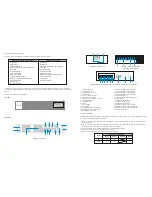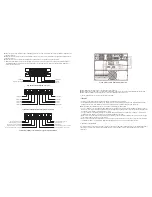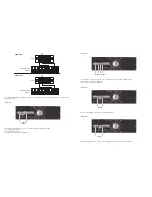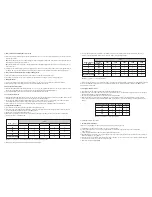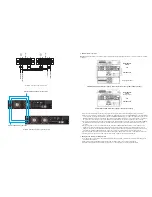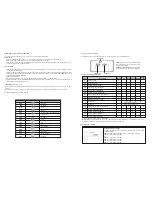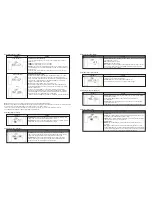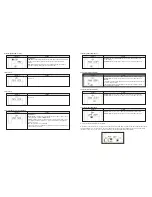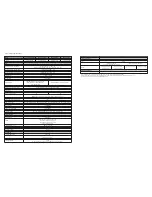
Parameter 2:
Sets the low voltage point in ECO mode. This setting ranges
from 5% to 10% of the nominal voltage.
Parameter 3:
Sets the high voltage point in ECO mode.
This setting ranges from 5% to 10% of the nominal voltage.
Interface
Setting
06: Voltage range for ECO mode
Parameter 2: Output frequency
To set the output frequency, choose any of the following three options in
parameter 2:
50.0Hz:
The output frequency is set to 50.0Hz.
60.0Hz:
The output frequency is set to 60.0Hz.
ATO:
When selected, the output frequency will be set according to the latest
normal utility frequency. If it ranges from 46Hz to 54Hz, the output frequency
will be 50.0Hz.
If it ranges from 56Hz to 64Hz, the output frequency will be set at 60.0Hz.
ATO is the default setting.
Interface
Setting
02: Output frequency settings
60 Hz, CVCF mode
Parameter 2:
Sets low frequency point for ECO mode. 50Hz system: Ranges
from 46.0Hz to 48.0Hz.
60Hz system: Ranges from 56.0Hz to 58.0Hz. The default value is
48.0Hz/58.0Hz.
Parameter 3:
Sets the high frequency point for ECO mode. 50Hz: Ranges
from 52.0Hz to 54.0 Hz.
60Hz: Ranges from 62.0Hz to 64.0Hz. The default value is 52.0Hz/62.0Hz.
Interface
Setting
07: Frequency range for ECO mode
Parameter 2:
OPN:
Bypass allowed. When selected, the UPS will operate in Bypass mode
depending on the enable/disable bypass setting.
FBD:
Bypass not allowed. When selected, the UPS will not be able to operate
in Bypass mode under any circumstances.
Parameter 3:
ENA:
Bypass enabled. When selected, it means that the Bypass mode is
activated.
DIS:
Bypass disabled. When selected, the automatic bypass may be used,
but manual bypass is never allowed. Manual bypass allows users to manually
operate the UPS in Bypass mode. For example, by pressing the OFF button in
AC mode, it will cause the unit to start running in Bypass mode.
Interface
Setting
08: Bypass mode setting
Parameter 2:
Sets the acceptable low voltage for bypass operation. Setting
ranges from 110V to 209V, with a default value of 110V.
Parameter 3:
Sets the acceptable high voltage for bypass operation. Setting
ranges from 231V to 276V, with a default value of 264V.
Interface
Setting
03: Voltage range for bypass
Parameter 3: Frequency mode
Enables you to set the output frequency in either CVCF mode or no CVCF
mode. You may choose any of the following two options in parameter 3:
CF:
Sets the UPS in the CVCF mode. If selected, the output frequency will be
fixed at 50Hz or 60Hz according to the setting in parameter 2. The input
frequency could range from 46Hz to 64Hz.
NCF:
Sets the UPS to normal mode (not CVCF mode).
If selected, the output frequency will synchronize with the input frequency
within 46~54Hz at 50Hz or within 56~64 Hz at 60Hz according to the setting
defined in parameter 2.
If 50Hz is selected in parameter 2, the UPS will transfer to battery mode
provided the input frequency does not fall within 46~54Hz range. If 60Hz is
selected in parameter 2, the UPS will transfer to battery mode provided the
input frequency does not fall within the 56~64Hz range.
*If ATO is selected in Parameter 2, Parameter 3 will show the current frequency
50 Hz, Normal mode
ATO
Note:
If the UPS is set to CVCF mode, the bypass function will be disabled automatically.
But when a single UPS without parallel function is powered on with utility power and before the UPS finishes the startup, there will
be a few seconds of voltage pulse (same as the input voltage) on the bypass output.
If you need to remove the pulse on this mode to better protect your load, you could contact the dealer for help.
This situation will not happen in UPS units working on parallel mode.
Parameter 2:
Sets the acceptable low frequency for bypass operation.
50Hz system: Setting ranges from 46.0Hz to 49.0Hz. 60Hz system: Setting
ranges from 56.0Hz to 59.0Hz. The default value is 46.0Hz/56.0Hz.
Parameter 3:
Sets the acceptable high frequency for bypass operation.
50Hz: Setting ranges from 51.0Hz to 54.0 Hz. 60Hz: Setting ranges from
61.0Hz to 64.0Hz. The default value is 54.0Hz/64.0Hz.
Interface
Setting
04: Frequency range for bypass
Parameter 3:
Enables or disables the ECO feature. You may choose between
the following two options:
DIS:
Disables the ECO feature
ENA:
Enables the ECO feature
When the ECO feature is disabled, the voltage and frequency range can still
be set for this mode, however, such parameters will take effect only if the
ECO function has been enabled.
Interface
Setting
05: ECO mode enable/disable
Summary of Contents for FDC-106KMR-ISO
Page 17: ......




